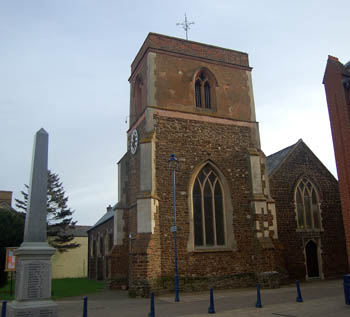
Saint Michael and All Angels from the west January 2007
The Bishop of Lincoln carried out visitations to Bedfordshire in 1717 and 1720 and for both of these a list of questions was sent out in advance, one of which enquired about the provision of schools in each parish. At that date Shefford was a township of Campton and the Rector of Campton noted in 1720: "There is no publick or charity school endowed. There is a private school at Shefford wherein some children are taught to read english [sic] and write. They are instructed in the Church Catechism & are brought pretty duly to Church". In 1717 he had noted that the number of children attending school (presumably this private one) was 30 or 40.
Either this school continued or another began because the Campton parish register records, for 1754 the baptism of Ann, daughter of Edward Abbis of Shefford, schoolmaster. A Joseph Cole is also mentioned as a schoolmaster in Shefford in the 18th century.
The paucity of records for the early 19th century for education in Shefford means that any reconstruction of events must be speculative. What evidence there is shows that Samuel Whitbread was intending to set up a school in Shefford as in the Whitbread correspondence [W1/855] is the following letter to him from his agent, J.Lilburne, dated 20th April 1809: "I have this day seen Mr.Weston again respecting the School Room at Shefford. Mr.Weston has a lease of the premises, five years of which was unexpired at LD [Lady Day - 25th March] last past. Mr.Arnold[?] who is his Landlord is willing Mr.Weston should let the building for the purpose of a school. Mr.Weston tells me the Rent must be £8-0-0 per Annum. All things considered it is by far the most eligible thing in Shefford for the purpose".
In 1818 a Select Committee was established to enquire into educational provision for the poor. This was no doubt prompted, in part, by the recent foundation of two societies promoting education and specifically the building of schools. The Society for Promoting the Lancasterian System for the Education of the Poor was established in 1808 promoting schools run along the lines pioneered by Joseph Lancaster, who had himself copied those of Dr.Andrew Bell, in which older children taught their younger fellows. The Society was renamed the British and Foreign School Society in 1814,. It was supported by a number of prominent nonconformists, Lancaster himself was a Quaker, and sought to teach a non-sectarian curriculum. In answer to this perceived nonconformist takeover of local education the National Society was firmed in 1811 to encourage the teaching of poor children along Anglican lines, including the catechism. The Select Committee sent a questionnaire to all parishes in the country asking for: particulars relating to endowments for the education of children; other educational institutions; observations of parish needs etc. The return for Campton and Shefford noted no endowment but mentioned a Lancasterian school containing 53 boys, supported, oddly, by the Rector. That this school was in Shefford is made clear by the return sent in by Southill which commented: "Some children attend a Lancasterian school in the adjoining parish of Shefford". The most likely thing, though by no means certain, is that this was the school established by Samuel Whitbread about 1809. It may have been in, or on the site of the Old School buildings, now the community hall; though this is highly speculative, as the note below on the 1833 return shows.
The 1818 return notes that there were also two Sunday schools maintained by the Rector and Sir George Osborn one consisting of 49 boys the other of 76 girls. In those days a Sunday School was just that, a school which met on a Sunday, usually in the church or nonconformist chapel or other similar building, teaching more than the religious topics with which they are associated today.
In the country generally the number of schools built continued to grow over the next fifteen years so that by 1833 the government agreed to supplement the work of the two societies, and local benefactors, by making £20,000 per annum available in grants to help build schools. It also prompted another questionnaire to be sent to each parish in England asking for details of local educational provision. The return for Shefford documented two daily schools, one for 34 boys (16 of whom were educated at the expense of the Rector of Campton, the rest at the expense of their parents). This is presumably the Lancasterian school. The other school "commenced 1827" had 17 boys supported by payments from parents. It seems reasonable to assume that one of these two schools eventually became Shefford School in or on the site of the current community hall, but which is anyone's guess without further evidence.
The 1833 return also notes that the Anglican Sunday school had 60 boys and 60 girls, that "supported by Dissenters", which had begun in 1825, had 35 boys and 68 girls with a library attached. One wonders if these were Methodists, Baptists or Roman Catholics, the latter being strong in Shefford. There were also schools teaching about a hundred pupils straw plaiting "and in some of these they are taught to read".
The next national enquiry was in 1846/7 when the Church of England made an enquiry as to all its church schools. This was against the background of a new Whig government which championed secular education and the increasing importance of nonconformists, particularly Wesleyan Methodist, and Roman Catholics in providing schools. The Anglican Sunday school in Shefford was now down to 21 boys and 32 girls, the daily school having 39 of each sex.